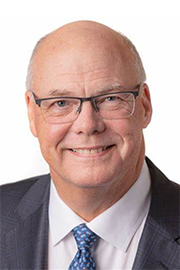- Oct/23/23 3:50:00 p.m.
- Re: Bill 135
My question will be to the member from Orléans.
I have to tell you, my mind is a bit boggled right now. Under the previous Liberal government, you were cutting nurses, you were leaving our hospitals lacking in infrastructure, in disarray.
These 14 separate home care organizations—it’s in fact the home care organizations that have been asking this government to make a change, to make it centralized. It’s this government that has been investing $80 billion this year in this health care system. So I have to say, instead of navigating 14 separate home care organizations and waiting for a call at home, now this at-home program will be a one-stop shop that provides people with easy access—
- Hear!
- Rabble!
- Oct/23/23 3:50:00 p.m.
- Re: Bill 135
After five years of government, the government should actually take responsibility for the things the government is or is not doing, and one of those things is the provision of adequately funded home care.
The government member says that their administrative reorganization of home care will somehow make things easier. Well, I don’t recall the administration reorganization of how licence plates are done making anything easier in Ontario—or, frankly, any of the other administrative changes this government has tried to make. In fact, I think we’re seeing lots of problems with the administrative changes they made around the sale of cannabis in our communities. So if they think administrative changes are going to provide more home care, they need to spend less time here at Queen’s Park and more time out in their communities talking to people.
- Hear!
- Rabble!
- Hear!
- Rabble!
- Oct/23/23 3:50:00 p.m.
- Re: Bill 135
This is something that’s very important, because our senior population is going to exponentially get bigger over the next 10 to 20 to 30 years, and home care is an essential piece. We know that when we speak to people who need care, their first preference—especially a senior wants to remain at home.
Under the Conservative government—home care used to be not-for-profit, and then a Mike Harris government changed all that and privatized it. And the Liberals, quite frankly, weren’t any better. They continued that privatization.
Would this member advocate and promote and actually make policy changes so that home care is not-for-profit and there’s not a profit extrapolated out of caring for vulnerable seniors at home and many other people at home? Would you support a not-for-profit policy in home care in this bill?
- Hear!
- Rabble!
- Oct/23/23 3:50:00 p.m.
- Re: Bill 135
It’s always a pleasure to rise in the House to discuss the issues that worry my constituents in Don Valley East and across Ontario, especially as it relates to something that is as important to all of us as health care.
On this occasion, I’m speaking about Bill 135, the amendments to the Connecting Care Act, which aim to provide some material changes to home and community care services here within Ontario.
My remarks will focus on five things: (1) the status of home and community care here in Ontario; (2) how this poor status came about; (3) some of the recommendations from stakeholders; (4) how Bill 135 doesn’t meet any of those recommendations; and finally, (5) exactly what is wrong with Bill 135.
Let’s begin with the status of home care here in Ontario. There’s no way to mince words here. It is a dysfunctional system marked by severe staffing shortages, high staffing turnover, frequent changes to nurses and personal support workers, and a remarkable—not in a complimentary way—amount of rationing of care, with less time spent per patient visit.
In order to illustrate this, I’d like to share the story of one of my constituents, and this constituent happens to be my constituency assistant. His father is bed-bound. His boss—me—is a member of provincial Parliament. His boss is a family and emergency doctor. Despite all of those levers, we still cannot get my constituency assistant’s father the home care services he desires—that he requires. This is a situation that has arisen the moment this government got its grips on home care.
How did this come about? Well, it boils down to a few things. We have a demoralized workforce that is burnt-out from the pandemic, that has moral injury from rationing care. They’ve been rationing care because this government hasn’t been able to retain health care workers—doesn’t have a strategy to retain health care workers.
We also have a problem with the proliferation of for-profit, private health care, again, impacting the retention of health care workers; imposing wage restriction and wage suppression to squeeze out profits; offering part-time work instead of full-time work so as not to pay out benefits; delivering lower quality, rushed care—public pain for private gain.
Then, of course, we have systemic underfunding, marked by Bill 124, leading to the proliferation of for-profit nursing agencies and staffing agencies. We have a government—this government—that isn’t even willing to accept money on the table from the federal government, $1.7 billion to raise wages for PSWs. They will not do it because they do not respect health care workers. And, of course, we have consistent and repeated overpromising—commitments of $1 billion given in the 2022 budget for home care, of which only about $150 million was released, and then in this year’s budget, a promise to deliver $569 million, although the last time the FAO reported on this government’s spending, they had already underspent by $1.2 billion.
So this is how we got there—ignorance, a lack of competence by the current government. We also already have a road map from many stakeholders—stakeholders such as the Ontario Community Support Association, which has said that a mere 10% wage increase would result in an extra almost 1,300 PSWs, would retain one in five PSWs who are about to leave. They said we need to achieve wage parity between home care, community care, long-term care and the acute-care sector. And they have said—and I agree—that we need to pay workers for all the hours worked, not just the ones in direct patient care.
This year, we’ve seen an increase to 76% of organizations saying that the health human resource crisis and inflationary pressures have forced them to either cut services or increase wait-lists.
Bill 135 ignores all of those things. Rather than doing any of those things, it puts the proverbial head in the sand. It ignores the root causes of our problems. It’s the equivalent of throwing darts at a dartboard in the hope that something sticks. Every single one of the fundamental problems plaguing our home care system is completely ignored. It does this because it actually—well, if anything, it makes things worse. It demolishes the existing home care architecture, eliminates 14 local health integration networks and replaces them with a half-baked, poorly conceived monolithic alternative that hasn’t been fully thought out. It proposes to provide home and community care services to patients, proposes to deliver operational supports, proposes to provide information to the public about health and social services and proposes to provide placement management services. Those are lines on a piece of paper. How it supposes to deliver those things? No idea. I met with ministry officials and asked them to tell me concretely what it will do and was met with nothing but business power words like “integration” and “connected care.” What does that mean? Why does this monolithic institution think that it can perform these tasks better than local health integration networks? Never clarified. It might, but if history is a judge, that is an unlikely proposition.
We saw, when Ontario health teams were proposed, they were delivered in a patchy, lumbering rollout that took place in an entirely ad hoc manner, lacking in consistency. Now we actually see that was an attempt to decentralize services.
This is an attempt to centralize services. We can’t even figure out a consistent pattern on the direction we want our health care system to move in. And the point is to centralize services with an expectation that—I don’t really know.
What I can tell you is that the last time we faced a process like this was when we tried centralizing autism intake services under the umbrella of AccessOAP. That has subsequently proved to be an entire disaster, with skyrocketing wait times and a ballooning list of kids exceeding 60,000.
I could go on and on and on, but I don’t have the time.
When I asked the ministry for an example of a single concrete problem that this organization would solve, there was no answer.
So pick your metaphor for this bill—it’s centralizing at one level, decentralizing on another; lipstick on a pig, as my colleague said; shuffling the deck chairs on the Titanic; a tale of sound and fury signifying nothing. I don’t know. It centralizes powers and the minister, who can just reward her friends, as we’ve seen with the greenbelt—
- Hear!
- Rabble!
- Oct/23/23 4:00:00 p.m.
- Re: Bill 135
My question is to the member from Don Valley East. I know that member was not here under the previous Liberal government, and I wasn’t here in this place either. I find it rich, coming from the member opposite, talking about everything our government is doing for health care, when they did for 15 years—absolutely nothing. When they tried to reform home care, it was a bullet point in a press release.
Speaker, as was mentioned in the news release, the goal of this legislation is to create integrated service organizations with home care—the Ontario health teams, which have been well-received by stakeholders in the province.
I want to provide one more quote from a website, and it’s a bullet point: “Promote coordinated care by establishing an integrated model for continuity of care.” That bullet point is from Bonnie Crombie’s leadership website—who this member endorsed.
Will he support this bill?
- Hear!
- Rabble!
- Oct/23/23 4:00:00 p.m.
- Re: Bill 135
I guess the Conservatives no longer choose to speak about their own legislation that they have before the House, which is unfortunate. We’ve definitely heard a lot on this side, just today alone, that the government members could have had a chance to rebut—or to tell their side of the story. But I think their silence is golden when it comes to our health care system and the privatization that they are full force ahead with here in the province of Ontario.
Today, we’re speaking—for folks who are listening in at home and may not have had an opportunity to hear, this is Bill 135, Convenient Care at Home Act. Again, it’s a fancy title—not quite fancy legislation to meet up to those expectations, as we’re actually just seeing more bureaucracy being created within the health care system.
We know, and I can pretty much bet on the fact that the government members, if they’re listening to their communities, are hearing the same things that I hear in my community of Hamilton Mountain, and that is the lack of services and availability to people who need home care in the province of Ontario. This encompasses seniors, people with disabilities, children with complex needs. So many folks, for whatever reasons, look to the home care services to be able to keep them home and safe in their homes and, hopefully, prevent long-term care, hopefully prevent them going back into the emergency rooms and then needing a bed in the hospital, to fix the things that were created due to the lack of home care.
We hear from people on a regular basis that are not able to get a bath—they’re not able to get a bath. They’re not able to get their toenails cleaned. Think of people with diabetes and the foot care that goes with that and the health care crisis that that creates. These are proactive measures that our home care system is supposed to be able to prevent. They’re supposed to keep people healthier, in their homes, keep them out of hospitals, keep them out of long-term care to stop the bottlenecks that we see throughout the system.
If this government truly cared about the people of this province, they would ensure that the home care system is robust, that it is strong, that it serves our most vulnerable residents in their homes, but that’s not what we see. We definitely are not seeing legislation coming forward to protect the citizens of Ontario.
We hear on a regular basis from folks, again, who are struggling within the health care system. And like I said, there are so many things that folks are looking for from home care, and it’s not in this bill.
SEIU was here last week. They talked about how one of their biggest challenges in the home care system is retention of staff. We know we have a severe shortage of PSWs in the province of Ontario that is mainly due to poor working conditions, poor wages, not being compensated for their travel time between clients, not being respected for the work that they do. So the government decided to put out an education program that was free to PSWs, to be able to encourage more folks into that education field and hopefully into the PSW system. But what we’re seeing is people who took the education and are PSWs for a day or two and they’re quitting, because they’re just not the folks who were meant for those jobs. Not everybody can do every job, and we know this.
I know, personally, I could never be a PSW; that is not within my realm. It’s not within my heart, to be able to provide those critical private services to so many folks. It’s just not. And I’m sure if people are honest with themselves they would say the same thing—that it’s not an easy job. Not everybody has it within themselves to be a doctor or a nurse, and a PSW is really doing those very private things, like bathing and toileting and things like that. Not all of us are built to do that.
So the government is offering free education to people who are finding, after they’ve taken the education, that they’re just not up for this work. And it’s far from glamorous work, and without glamorous pay to encourage it, it’s just not working for folks. They’re seeing that it’s actually costing them money or costing them whatever it is to do that work, and so they’re leaving as quickly as they’re getting in. So the retention of PSWs is still a great concern.
The other piece that I want to make sure that I talk about today is critical care nursing. I’ve met with families from the Ontario Disability Coalition who have brought their stories forward of their children who are in critical complex care and need around-the-clock nursing at home and not able to get that because they don’t have enough money to be able to pay the nurses that are now being hired through temp agencies. So that has increased the cost of nursing to the homes that—and these families who have been made bosses and contractors over their own children’s health care are left without enough money to be able to cover the number of hours that are needed for those children and families who are burning out and struggling. So if the government truly wanted to bring forward good legislation, maybe that should have been something that they considered, instead of creating more bureaucracy that I’m sure will take more money out of our health care dollars that are so desperate in our communities.
I see here within the bill, Speaker, that the bill creates an arm’s-length agency of a board of directors who are appointed by the minister, which to me is very concerning because we have definitely seen so many political appointments happening under the Ford government with really no resumé for those folks to be able to fit the need of whatever agency or appointment it has been. So when I see that it is the minister who appoints—the board must consist of the following members: up to six members appointed by the minister and up to three members appointed by the minister on the recommendation of Ontario Health, who are already appointed by the minister.
It’s just a continuous push towards privatization in our health care system. We know that the privatization, in the first place, of our health care system began under the Harris government, which was Conservatives also, and created the spiral of what we have seen to date. We have seen, under Harris, nurses laid off, hospitals closed, and the privatization of our long-term care and home care began. Unfortunately, it’s mind-blowing, but that also led to a very fruitful future for the Harris family, because Mike Harris became the chair of the board of directors of Chartwell, making a very wonderful pay with also millions of dollars in holdings throughout the Chartwell system. And then his wife and he created a home care system; it was the Nurse Next Door, providing private nurse services into the community, which is now the Care Company. That is temp agency that provides nursing at a very high, hefty cost to the community or to whatever services those nurses are needed in. And the profit that they’re making is actually being siphoned from the patient care that is needed within our health care system. Now I know there are billions of dollars that go into our health care system, but I would love to see the numbers of how much of that is now actually going to for-profit services that really should be instead funding these critical services to keep people out of hospital and healthy in their home.
We also know that the government underspent our health care system by $1.2 billion—again, more dollars that could have kept people safely in their homes, making sure they had baths, making sure that someone was cleaning their toilets and helping them keep their homes clean to prevent infection. We see PSWs running in and out of people’s homes within a half hour and not really, truly providing the service that they need to keep them safe and healthy. It’s very, very concerning.
I can tell you, the seniors in my community that I talk to, they’re scared. They’re terrified about the system that they may find themselves in in not that many few years away. These are still healthy-bodied seniors, but they know that once they start getting sick or start having health conditions, they’re going to be put into a system that they don’t want to be in.
Literally yesterday, as I went into my local pub to pick up some takeout dinner for my family before coming in last night, I came across a group of seniors sitting at a table. I had never met them before. They noticed who I was. They called me over to the table, and they said, “Monique, please stick up for the seniors.” And they said to me, “The next time you get up, we need you to say”—and that was yesterday—that they’re terrified. And the cost of living that they are seeing, they are so concerned about that. The cost of eye exams—I heard it from them at the table, and yet I was on the phone with my father earlier in the day, who was telling me he had to pay $75 for an eye exam to be able to go through his driver’s license. It’s a snowball effect that this government is creating, and the fight that they had with the optometrists has created this also.
From my mom the other day, I get that she’s—the HCHC Family Health Organization, the service guide for uninsured service fees that doctors are now charging for: back-to-school notes, children’s aid society medical certificates, sick notes, death certificates, prescription renewals, administrative costs for vaccines and shots, transfer of drivers’ medical examination reports—all of these costs on this uninsured service guide are now being filtered to the people of Ontario, and seniors are having to eat up these costs. She had to buy into an insurance program because the actual costs aren’t as high as the cost if you’re not insured. So for her, as a senior, she had to pay another $90 to her doctor so that when she needs a prescription referral or when she comes up on her driver’s medical exam, she’s covered for it.
In the letter, this is what it said: “This is not a decision we came to lightly. It’s frankly not something we have any desire to undertake. The situation is such that we simply have no choice. The financial landscape in the country is one of heavy inflation. The cost of running a medical practice has skyrocketed, and the government has refused to even come close to helping us meet these inflationary demands.” You’re the government, over there on that side. This is you that they’re talking about. “We are at the point where the choices were to close the practice, to significantly cut back on services to patients (i.e., hours, clinic, staffing) or to begin collecting payment for uninsured services. So, we have collectively made the difficult decision to do the latter.” It’s very, very disturbing that this is the privatization schedule of this government.
I have heard the Premier say over and over and over again that you’re going to be pulling out your OHIP card, not your credit card. Well, let me tell you, my mom had to send over her credit card, and my mom is not alone; I just happen to have her forms with me. A credit card to pay for services that this government is refusing to pay for in our health care system: That is not the health care system that was dreamt of so many years ago in Canada. Ontario is blowing it up.
I came across—somebody actually sent me an Instagram of Tommy Douglas, and it was one I hadn’t seen before. It was really cool to watch Tommy. It’s in black and white, and we all know this is back in the 1950s, 1960s, when he introduced medicare into Canada. I’ve got the actual transcript of what was said, and I would like read some of that, just for historical purposes, into Hansard.
Tommy says, “I would propose in the act that we say the federal government will enter into a 50/50 arrangement”—I agree, because the members are going to say the federal government is not paying 50/50, that they should be, because that’s what’s coming—“with the provinces to institute nursing care, home nursing care, Meals on Wheels, that we would share 50% of the cost of setting up community health clinics that would start a program of dental care among school children.” This is back in the 1950s that the vision of health care was happening, and this was Tommy Douglas.
And the interviewer said, “But in other words, we should dictate the services that we are going to pay for?”
And Tommy said, “No, we dictate the ones we are going to pay for. We would say, ‘These are the programs we are prepared to share with you on a 50/50 basis.’ Now, there is no way by which the federal government can dictate to. The problem is that they must undertake those programs. But they can say to the provinces, ‘If you want to institute these programs, we will pay 50% of the cost.’ I think what most people miss is the essential point, mainly, that the provinces are even more interested than the federal government is in cutting costs down because the provincial governments are much less able to finance their half of the cost than the federal government is. So if the federal government is worried about escalating costs, just imagine what little provinces like New Brunswick and Newfoundland and Nova Scotia feel about rising health care.”
You know, it goes on, but I just wanted to put it out there that back in the 1950s he was talking about nursing care, home nursing care, Meals on Wheels, community health clinics, a dental program They’re the same things the New Democrats continue to fight for today. They’re the things that we know keep people healthy in their homes.
When we are providing proactive services, it keeps people out of emergency rooms, which we know are the high costs. Keeping people in hospitals, keeping people in long-term care—that’s where the expense is. Providing home care keeps people at home safely for much cheaper cost and a much bigger return.
I see I’m out of time already; that went very fast. I just want to see if I had anything else here.
Home and Community Care Support Services: A big report has come out from them because of the crisis in the system and what people are saying and how “All of these issues are creating anxiety and despair and placing elders at risk of hospitalization and institutionalization.”
Folks across this province are speaking out. They know that we need a health care system that works. This bill is not going to provide that. It’s creating more bureaucracy that, again, will end up for-profit and in people’s pockets instead of in our health system.
- Hear!
- Rabble!
- Oct/23/23 4:00:00 p.m.
- Re: Bill 135
My question is to the member for Don Valley East.
I would say there’s one business power word that I would respectfully submit, and that is the word “accountability.” For the first time in about 15 years, this government is accountable. We’re trying to make changes. We believe that home care is the best.
What part of this bill do you support—instead of being against it?
- Hear!
- Rabble!
- Oct/23/23 4:00:00 p.m.
- Re: Bill 135
In fact, in the last election, we proposed a dramatic change to home care that would ensure that it was not-for-profit and based on a more centred-in-community-based model. I think if there is government funding available, that funding should go to helping people directly by hiring PSWs, nurses, other support workers—the things that they need. If you have a profit centre involved in that, obviously, those people are skimming off the top and there’s less money available to support people where they live.
- Hear!
- Rabble!
- Hear!
- Rabble!
- Oct/23/23 4:00:00 p.m.
- Re: Bill 135
I always like to stand up here and tell the truth, and I’m not really sticking up for the Liberals, but the reality is, under Mike Harris, you laid off 6,000 nurses—let’s be clear on that—and you closed multiple hospitals. So let’s at least be accurate and tell the truth on that particular issue.
I see the labour minister is here, so I’m going to ask this question to the Liberal, hoping that he hears me. This bill does not guarantee that the Ontario Health atHome workers will be unionized or full-time positions with real wages, real benefits and pensions. So my question to the Liberal—either one; it doesn’t matter who answers: Do you believe that people who work in home care should be unionized, should have full-time jobs, should be respected, should have pensions and belong to a union? If you want to improve wages, you need to join a union in this province.
- Hear!
- Rabble!
- Oct/23/23 4:00:00 p.m.
- Re: Bill 135
Well, that’s a bullet point on a leadership commitment; that is not a full-out bill.
When I asked ministry officials to explain how they were going to deliver on those business power words, they couldn’t tell me.
And while we’re talking about the things that have or not been done, let’s talk about what this government has accomplished. It has accomplished 2.2 million Ontarians without a family doctor. It has accomplished a backlog of medical services that exceeds 22 million. It has accomplished rampant ER closures in almost every community across this province, including in the Minister of Health’s own riding. That’s not a track record to be proud of.
Madam Speaker, through you: I would invite members of the government to tell me exactly how they propose to actually deliver integrated connected care, apart from just listing bullet points and finding things off websites.
- Hear!
- Rabble!
- Oct/23/23 4:00:00 p.m.
- Re: Bill 135
I would like to direct my question to the member from Don Valley East. I understand that he’s a doctor, and his question was about what this government did to extend primary care, or how many millions of Ontarians don’t have doctors—and I would like to put the question back to him. I am one victim of this. My wife took seven years outside the province to be able to get her licence here. She is a doctor. It took her 10-plus years to be a doctor in Ontario. When we connected to the Minister of Health at the time, who was a Liberal, he said, “We can’t do anything. We don’t have the spots.” Not only that, all the IMGs across the country had 24 spots—to get an internship in this country, during the Liberals’ time.
- Hear!
- Rabble!
- Hear!
- Rabble!
- Oct/23/23 4:20:00 p.m.
- Re: Bill 135
Mountain.
But she did talk about creating another team, and we’ve heard already in the House—we see the access to OAP and what that’s doing, and it’s really not creating any help within the system. There is no assistance to ensure that people are getting the services they need when they need them.
Also, she’s not thinking about the diversity across this province. We heard from the member from Mushkegowuk–James Bay that the services out there are completely different. People need doctors; they need family health care. Instead, they’re creating bureaucracy.
- Hear!
- Rabble!
- Oct/23/23 4:20:00 p.m.
- Re: Bill 135
Now, we’re moving from 14 organizations to a single-organization model, and this is going to provide a strong and centralized foundation to support the stability of the home care services now and into the future.
The Ontario Health Teams—they’re going to be taking on the responsibility. The organization would provide ongoing operational supports and care coordination to those teams. This is not a layer, but a support partner for OHTs, and planning and delivery.
This being said, in the past, the opposition has voted against our government’s proposals to make health care delivery quicker and more reliable now for constituents in your community.
So I ask the member from Hamilton—
- Hear!
- Rabble!
- Oct/23/23 4:30:00 p.m.
- Re: Bill 135
In my riding, in Essex, we have lots of people entering the career of PSW because of the steps taken by this government, and the member opposite made reference to the number of PSWs available in the marketplace and available to deliver the services required. I can tell you that I went to Anderson College and talked to the trainees there and they were very happy to have received free tuition and free books from this government to get their training, to get more PSWs. I know that that program is being taken up very well by the people in the riding of Essex.
My question to the member is, is she aware of how many people in her riding are benefiting from the remarkable program introduced by this government to pay the tuition and pay the books for PSWs entering that profession?
- Hear!
- Rabble!
- Oct/23/23 4:30:00 p.m.
- Re: Bill 135
Thank you to the member from Niagara Falls. I said in my statement today that this was created by Mike Harris, and we’re seeing, just in that family alone, the money that is being made. The people across the long-term-care system, the for-profit—we’re seeing the money that is being made and what that does to the seniors’ care, and every little thing that’s extra, the seniors are paying for once again. I don’t know where the government thinks that seniors who are living—and so many of them below the poverty line are expected to be able to pay for services without the support necessary.
So it’s for-profit. It’s making a lot of people very rich. But it’s not helping the people it’s supposed to serve.
So there are so many challenges that people who need these PSW services face that are just not taken into consideration by this government. When you have a for-profit system, the shareholders and the stakeholders are only there for profit. At the end of the day, they want their return and it doesn’t matter, by the looks of it, what system is given to the province of Ontario. Patients and seniors and people with disabilities in our province deserve so much better than to be put at the end of the line and profit at the beginning.
So I’m not sure where it is confusing that we don’t trust them to put forward legislation that actually benefits the people of this province. We have serious concerns with pretty much every piece of legislation that they put forward, and that’s not just because it’s theirs, it’s because of what it’s written in: It’s written in the people of Ontario’s blood. It’s a mess. It is a mess, and we have seen it time and time again.
The government needs to get off the privatization track and actually invest in public health care instead of breaking it.
- Hear!
- Rabble!
- Oct/23/23 4:30:00 p.m.
- Re: Bill 135
From reading this bill, it looks like it completely leaves open the service delivery arm of home care to private, for-profit companies. We know that private care almost always leads to worse care. We saw that in long-term care, where 6,000 of our seniors died in long-term care, but 78% of them died in private care. Could the member discuss why this government would allow private companies to continue to control home care in this province after seeing what’s happened in long-term care?
- Hear!
- Rabble!
- Oct/23/23 4:30:00 p.m.
- Re: Bill 135
I’m honoured to rise on behalf of the residents of Ottawa West–Nepean to speak about Bill 135, the Convenient Care at Home Act. This bill amends the Continuing Care Act to create a subsidiary of Ontario Health called Ontario Health atHome, amalgamating the 14 current Home and Community Care Support Services into a single agency that will be responsible for home and community care services in the province.
I just want to clarify for my constituents that what we’re talking about here is the agencies that used to be called community care access centres, then local health integration networks, then Home and Community Care Support Services and now Ontario Health atHome. That’s a lot of name changes in just six years—I hate to think how much money has gone to updating business cards and letterhead—and the result is that, when constituents talk to me, they usually end up picking one of the names and then tagging on, “or whatever it’s called now.” If one of the goals is easier and simpler access to care, I’m not sure another name change would have been at the top of my list, but here we are.
Last year, I had the opportunity to tour the Queensway Carleton Hospital in my riding of Ottawa West–Nepean, an important institution which provides incredible care to residents in the west end of Ottawa and the Ottawa Valley. Dr. Falconer, the CEO of the Queensway Carleton, made a point of taking me to the acute care for the elderly unit, a relatively new unit at the hospital. He told me that the acute care for the elderly unit was created because a significant number of the admissions to the Queensway Carleton are seniors, and they know that every day that a senior spends in a hospital bed they are 50% less likely to ever live independently once again. The acute care for the elderly unit works incredibly hard to shorten hospital stays for seniors to get them up and moving again, get them back on their feet as quickly as possible so that a hospital stay doesn’t rob seniors of their independence. But oftentimes, going home safely means having home care and community care services available, and this is where the system is breaking down, Speaker.
Earlier this year, hospital CEOs in eastern Ontario sent a letter to this government, and I’m going to read it to you. It’s addressed to the Minister of Health: “We, the undersigned representatives of acute care hospitals in eastern Ontario, are writing in support of Ontarians who require community support services to live at home.
“We clearly understand both the challenges and the potential of our health care system. The sustainability of supports in the patient’s home and in the community is critical to our ability to effectively respond to the acute care needs of our communities.
“Community support services are a key part of a proactive and responsive solution to health care pressures. We are writing to raise the alarm that a robust, well-funded community support sector is required to respond to the needs of Ontarians, in partnership with hospitals. Without realistic and meaningful funding to community support services, patients in our community will suffer and acute care hospitals will continue to see growing numbers of ALC patients.”
It’s signed by 12 CEOs of acute care hospitals in eastern Ontario, including Dr. Falconer of Queensway Carleton.
These CEOs signed this letter because they understand that when we don’t have a strong community care sector, more patients end up in the hospital and they stay in the hospital longer, because the supports are not there to get them home. Our hospitals depend on a strong home and community care sector so that patients can go home safely, with the supports they need to help them on their recovery journey. But you would never guess that from the way this government funds home and community care, Speaker. The sector is so vastly underfunded that they are in crisis, and what funding the government has promised they don’t seem to be able to actually get out the door, deepening the crisis and pushing organizations to the brink of collapse.
One executive director of a not-for-profit home care organization told me this summer that he’s not sure how much longer his organization can keep subsidizing the government as they wait for promised funding to flow. He is warning of collapse. What I am hearing from all of the community support sector organizations in Ottawa West–Nepean is that their workers cannot continue to subsidize this government’s underfunding of this sector. The workers feel that they are being asked to make up for the government’s stinginess with their time, their hearts and even their wallets. They are burning out trying to fill in the gaps left by this government’s failure to properly invest in and stabilize the system, and so they are leaving the sector.
The organizations that are providing not-for-profit home and community care in my riding—Carefor, the Olde Forge, Jewish Family Services of Ottawa, Meals on Wheels—are all having difficulty recruiting and retaining staff, and a big part of that is fair compensation. But you can’t offer fair compensation if demand is going up and inflation is going up but your funding is not. Between 2012 and 2023, the community support sector received only a 3.5% increase in funding. Inflation over this period, meanwhile, was 27.5%.
The people who work in this sector are great. I have really enjoyed getting to know them and seeing them in action. They are compassionate, energized and committed, but they are not magicians. They cannot make less money, provide more care and better wages.
Last year and earlier this year, community support sector organizations in eastern Ontario worked hard to draw the Minister of Health’s attention to this issue. They warned of the serious situation in the sector and the need for more funding in order to be able to continue providing care for seniors, for people living with disabilities and for people coming home from the hospital in eastern Ontario.
Let me read from a memo that was submitted to Ontario Health East and signed by 31 community support sector organizations in eastern Ontario: “The community support sector is faced with presenting and/or living within annual budgets that are not sustainable and simply cannot be balanced. In many cases, providers are anticipating significant deficits—percentage in the double digits.”
The memo goes on to say, “Organizational foundations are crumbling, in the face of exponentially greater challenges and pressures. Timely and significant funding increases are needed to build organizational responsiveness and resilience.
“—Service reductions are inevitable in the absence of realistic annual budgets. As the aging population with complex health conditions increases, service reductions will be counterproductive to building a responsive health care system.
“—Current deficit budgets may result in increasing client fees to a level that would limit access for the most vulnerable, low-income clients striving to age at home. Raising the client co-pay fee for service adds yet another barrier to Ontarians in need.
“—Inflation rates currently sit around 6.8%. Patients are finding it difficult to make ends meet and are often faced with tough economic trade-offs, when considering their health care needs. Employees are leaving CSS employers, and the health care sector in general, in favour of employers able to offer higher compensation rates, and incentives.”
The memo concludes, “Community support service providers seek to be viewed as valuable contributors to a robust health care system for Ontario. We are part of the solution to current pressures. We share Ontario Health’s goal to ‘connect, coordinate and modernize our province’s health care system, working with all partners so that everyone in Ontario has an opportunity for better health and well-being.’ Current Ontario Health funding does not support the effort needed to align with OHE goals.”
These organizations warned that they needed a funding increase of 10% to 15% in order to be able to continue to provide the same level of service, and that without this level of funding they would have to implement service cuts of up to 40%. And let’s be very clear what we’re talking about here, Speaker, because I know 15% sounds like a lot of money, but home and community care are actually some of the most cost-effective forms of care that we have in Ontario. The average cost of a hospital stay is just under $7,000 in Ontario, which is actually on the low side when we look at health care in Canada, because our government grossly underfunds hospital care too.
But hospital care is an expensive form of care. The daily cost of hospital care for an individual, according to the Financial Accountability Office, is $722. The daily cost of home care for an individual is just $36. And what did the community support sector organizations in eastern Ontario say they needed to maintain service levels and not have to implement any cuts or fee hikes for patients? Just $7 million. The government’s health budget for 2023-24 is $81 billion, Speaker; $7 million isn’t even a rounding error for a budget of that size. And yet the government could not bring itself to act, despite the fact that community support services are incredibly important and far more cost-effective than acute care services, despite the fact that they reduce the need for acute care services and despite the fact that there is strong demand from Ontarians, who after the past few years have been very clear that they want to age in place—not in long-term-care facilities, not in hospitals, but at home.
I raised these concerns on their behalf multiple times in this House. On March 30, I asked the government about imminent cuts to the dementia program at the Olde Forge Community Resource Centre, leaving 95 seniors with dementia without their day program. The government House leader smirked about how this government wants seniors to work and participate in the economy.
On April 19, along with the member from Ottawa Centre, I asked the government why they were allowing prices to increase 300% for Meals on Wheels for the lowest-income members of our community. The Minister of Health stood and said she had increased funding—an increase that was absolutely not seen on the ground by those members of our community now paying 300 times more for their food.
The government did not heed the warnings of so many health care leaders in eastern Ontario that increased funding for the sector was vital. They ignored the call for urgent investments. They allowed those 95 seniors at the Olde Forge to lose their dementia day program. They allowed prices at Meals on Wheels to skyrocket, resulting in some community members having to cancel because they could no longer afford food.
And then finally—finally, Speaker—a glimmer of light: The provincial association for home and community care organizations, the Ontario Community Support Association, received a verbal assurance from the minister that some additional funding was going to be coming to the sector, but what followed is what I call the summer of chaos, because for a long time no one in the sector knew what was happening. The cuts and the price hikes were already implemented. The minister refused to put the commitment in writing. Organizations were being told different things by Ontario Health about how much funding might actually be coming, then finally, an increase was confirmed, an increase of around 3% for most of the organizations in my riding, but no one could tell them whether it was one-time funding or base funding. You cannot hire more staff with one-time funding. You can’t offer wage increases to staff and then take them away. Ontario Health’s communication could not have been more abysmal.
Finally, in September, organizations received confirmation that funding increases will be considered base funding, but they’re being told they must raise wages and serve more clients with just 3%. What the organizations in eastern Ontario are telling me is that this is just a drop in the bucket compared to what they need. What they really need is funding increases of 15% in order to be able to increase wages, lower fees and expand services to meet the level of demand. This is staving off near death; it is not sustainability.
Furthermore, in order to make a difference, the money actually has to flow, and what I am hearing is that it is still a commitment that has not materialized. You can’t pay workers with promises, because workers can’t pay for rent and groceries with promises.
I wish this was a unique circumstance, but sadly, it’s not. In early 2022, the Conservative government promised a billion dollars for home care and $100 million for community support services. Sounds pretty good, right? But a year later, only a fraction of that money had actually been delivered, just over 10% of the money for home care and less than 30% of the money for community care. Organizations were left to plead with the government to actually deliver what they promised.
Carefor CEO Steve Perry told the Ottawa Citizen, “We are going to run the risk of collapse, or at minimum of service rationalization.” Carefor’s inability to compete for staff with other parts of the health care system meant that between 2020 and 2023 Carefor’s workforce was down 25% of its nurses, 28% of its PSWs and 15% of its community support staff. According to the Citizen, these shortages meant a 21% reduction in home nurse visits, a 14% reduction in PSW visits and a 13% reduction in community care services, all because this government can’t seem to get promised funding out the door.
So how long will home care and community support sector organizations have to wait for this new, still inadequate amount of funding to actually arrive? This is the reality of home care and community care in eastern Ontario.
What will this bill, the Convenient Care At Home Act, do to address these challenges in the sector? Not a darn thing. In fact, the procurement process envisioned by this bill has the potential to make things much, much worse, because what this bill envisions and what the Minister of Health has said is that once Ontario Health atHome is created, the plan is for this new agency to procure home care services through requests for proposals, similar to the process Ontario Health is currently using, and as my colleague the member for Nickel Belt, the official opposition’s health care critic, has pointed out, if this is just like the current procurement process, then what we are talking about is RFPs that will go out for service providers that can provide care to the whole province. And who is going to be able to bid on a multi-year contract to provide home care to all of Ontario? Not Carefor, a not-for-profit home and community care organization that has provided excellent care in Ottawa for 125 years; not Jewish Family Services, which provides excellent, culturally sensitive care for Jewish seniors and diverse seniors, many with language barriers, in Ottawa; not the Olde Forge, which has provided supports to seniors in Ottawa’s west end for more than 50 years. These local, not-for-profit organizations don’t have the resources or, frankly, the mandate to bid on contracts to provide care for the entire province. It will be the big, for-profit companies, like Bayshore and Extendicare, that will be in a position to bid for province-wide contracts.
Let’s talk about what that will mean for seniors, for people living with disabilities, for people with chronic or complex health needs in Ottawa West–Nepean. These are companies that siphon off our precious health care dollars for the pockets of their shareholders. How do they do that? They pay their workers extremely low wages and then bill the province double, sometimes triple, what the workers are paid, with the difference going to the shareholders, not the workers. They also refuse to pay workers for travel time and travel costs, so home care workers in some parts of the province work 10-hour days, but they’re only paid for six of them and they’re not compensated for the cost of gas or of using public transportation.
As you might well imagine, Speaker, this makes it very difficult to recruit and retain workers, because who would want to work in these conditions? These workers are essentially subsidizing the shareholders of large, for-profit companies with their time and their expenses. Nobody can sustain that over time, so workers are constantly leaving, for-profit companies are perpetually short-staffed and patients are left to deal with shortages and a revolving door of care providers.
Another thing these companies do is book patients back-to-back even though they live miles apart, as if workers are going to apparate from one location to another as if they’re wizards in a Harry Potter novel. Or they double-book patients as if workers have a time-turner that they can just turn back to go back in time to serve another patient at the exact same time.
The result of these unreasonable demands and the workforce instability is complete chaos and lack of care for patients. Care visits are routinely being missed or cut short. Caregivers change on a weekly basis. Family members are being told by caregivers that they are supposed to provide key elements of care. These are complaints that my office hears constantly from local residents receiving care from for-profit health care providers.
What my constituents need is not something that opens the door to further privatization of home and community care. What they need is high-quality, reliable care delivered by a qualified, well-compensated and stable workforce. But that means making the necessary investments to actually stabilize the workforce—to expand care rather than to cut it.
Unfortunately, what we see from this government time and time again is the opposite, and now we have another bill that opens the door to further privatization. It’s time for the government to stop its ideological attack on our public health care system and focus its attention on delivering high-quality care to Ontario residents who deserve no less instead of rewarding health care profiteers.
Report continues in volume B.
- Hear!
- Rabble!













